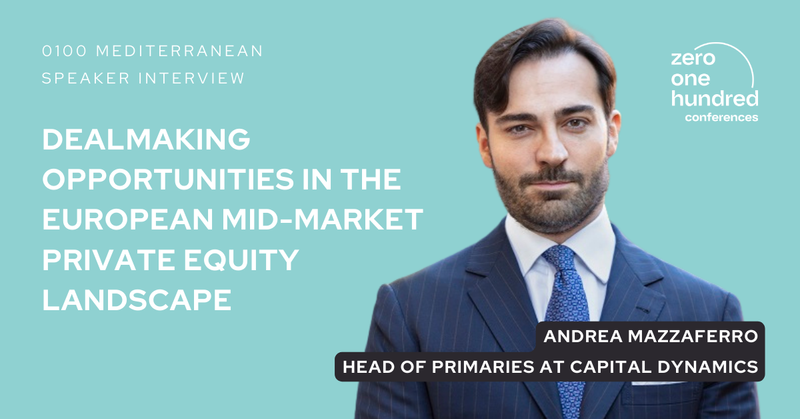In this preview interview for the upcoming 0100 Conference Mediterranean, we had the privilege to speak with Andrea Mazzaferro, Head of Primaries at Capital Dynamics, who will participate in the opening panel: PE & VC Environment in Europe and the Mediterranean region: Current State & Future Perspectives. Andrea offers his expert insights on the evolving private equity and venture capital landscape, mid-market trends, and sector-specific opportunities. He also highlights the growing significance of ESG integration and Capital Dynamics’ forward-looking strategies for the region.
Capital Dynamics is a global asset management firm specializing in private equity (primaries, secondaries, co-investments) and clean energy. Founded in 1988, the firm serves institutional and private wealth investors with tailored solutions. It manages over USD 14 billion in assets and operates across 13 offices in Europe, North America, and Asia.

The opening panel will feature industry leaders like Massimo Vendramini (AURELIUS), Wadih Manneh (Arab Bank Switzerland), Nicolas Petitjean (Partners Group), and Andrea di Camillo (P101).
How would you describe the current landscape of private equity and venture capital in Europe and the Mediterranean region? What key trends are shaping the market today?
Dealmaking in Europe gained momentum in the second quarter after a slow start to the year, largely driven by improving macroeconomic conditions, declining inflation rates and the European Central Bank’s initial interest rate cuts have contributed to this recovery. However, a full market rebound remains constrained by ongoing economic and political uncertainties, as well as difficulties in securing financing.
On the fundraising front, the market shows a clear divide. Mega funds continue to dominate, with the top five funds last year accounting for more than half of the total capital raised. In contrast, smaller funds are facing a challenging fundraising environment, requiring an average of 18 months to reach a final close.
Investment patterns are also shifting, with the mid-market gaining increased attention and market share from larger deals. This trend is partly due to the availability of financing, as mid-market transactions typically rely on less leverage. Additionally, the valuation gap between buyers and sellers is narrower in the mid-market, making deals easier to close.
From a valuation perspective, the market remains attractive, with multiples continuing to decline and stabilizing around 9x EBITDA in the mid-market. Despite this overall decline, there's a clear bifurcation: high-quality assets still command premium multiples, while the number of deals closing below 7x EBITDA is hitting a new record high.
From a fund-of-funds (FoF) perspective, what opportunities do you see in European mid-market funds, and which sectors show the most potential?
The current bifurcated fundraising environment presents an interesting opportunity to invest in “late primaries”. Many funds begin deploying capital during their fundraising phases, allowing for in-depth due diligence on early investments. In several instances, we have identified funds that are already 40-50% invested into high-quality assets. This offers investors a chance to enter with greater visibility into the portfolio's potential, often capturing value at an attractive markup as these early assets in the portfolio perform well.
The European mid-market is also seeing a shift from generalist to sector-focused strategies, mirroring a trend observed in the U.S. market several years ago. Funds with deep sector expertise tend to exhibit stronger capabilities in deal origination, value creation, and risk-adjusted return. This shift creates compelling opportunities in sectors such as healthcare, technology, and financial services, which have consistently delivered attractive performance.
Additionally, the current market landscape is especially favorable for value investors and those with experience navigating complex situations. As valuations adjust and the economic environment stabilizes, there is growing potential to acquire quality assets at more attractive prices. Corporate carve-outs are becoming increasingly common as companies seek to streamline operations and divest non-core assets. These carve-outs often involve complex deal structures and operational intricacies, making them well-suited for private equity firms skilled in unlocking value through strategic management and operational improvements. As a result, the year ahead promises significant rewards for investors adept at identifying undervalued opportunities and handling complex transactions."
With ESG and sustainability becoming increasingly important, how is Capital Dynamics integrating these factors into its PE & VC strategies in the region?
At Capital Dynamics, corporate responsibility is central to our approach. We understand the growing importance of ESG and sustainability, and we have fully integrated these principles into both our Private Equity and Clean Energy strategies. Our practices are aligned with the United Nations-supported Principles for Responsible Investment (PRI) and the Sustainable Development Goals (SDGs), embedding these standards throughout our investment process.
To ensure transparency, we use our proprietary R-Eye™ Rating System, providing clients with clear insights into the sustainability performance of their investments. This system, based on the 17 Sustainable Development Goals, evaluates investments using 10 to 12 Responsible Investment criteria, depending on the strategy. We assess potential investments against these criteria to determine whether to proceed with due diligence or refer them to our Responsible Investment Committee for further review before making a final decision.
Once an investment is made, we continually monitor and update its R-Eye™ rating throughout the holding period. Any changes in the rating are communicated to our investors, and we have procedures in place to address any significant Responsible Investment issues that may arise.
From an investment perspective, we continue to support managers who can demonstrate strong ESG value-creation capabilities. We have also invested in a select group of Article 9 buyout funds. The impact investing sector has evolved significantly, shifting from a focus on venture capital to drawing increased interest from buyouts and growth managers.
How are LPs responding to the evolving private equity and venture capital landscape in Europe, particularly in the Mediterranean region?
LPs are showing increased interest in the Mediterranean region driven by several compelling factors. One key attraction is the relatively low penetration of private equity in this market. Compared to more established European regions, the Mediterranean offers less private equity activity, providing LPs with opportunities to invest in large economies at potentially more favorable entry valuations.
Additionally, the region is experiencing a significant demand for succession planning, particularly among family-owned businesses and long-standing enterprises. Many of these businesses are seeking new ownership or strategic guidance as they transition to the next generation. For LPs, this represents an opportunity to invest in companies poised for growth and modernization, often with the potential for significant value creation.
Moreover, LPs are increasingly focused on ESG factors and impact investing, placing greater emphasis on ensuring that their investments not only deliver strong financial returns but also align with sustainability and responsible investment principles. They are seeking funds that integrate ESG considerations into their investment processes to meet this growing priority.
Looking ahead, what are your predictions for the future of private equity and venture capital in Europe and the Mediterranean region? What role will Capital Dynamics play in driving this growth?
As the market becomes increasingly competitive, General Partners who can demonstrate superior sector expertise, distinctive origination strategies, and robust operational capabilities will stand out. We expect the mid-market segment to continue leading the private equity landscape, particularly in a prolonged high-interest-rate environment. This is driven by the larger volume of deals in the mid-market and the ability to operate with less leverage compared to larger transactions.
We aim to strengthen our position as a leading player in the European mid-market ecosystem. Our strategy includes supporting Managers through primary investments, secondaries, and co-investments, all while targeting superior risk-adjusted returns for our investors. Our involvement in these areas is designed to drive growth and generate value, reinforcing our role as a key market player. Additionally, we will continue to prioritize ESG investing by focusing on sectors aligned with global trends and fostering innovation across Europe and the Mediterranean region.

